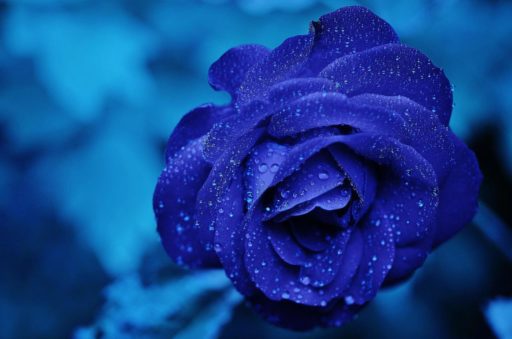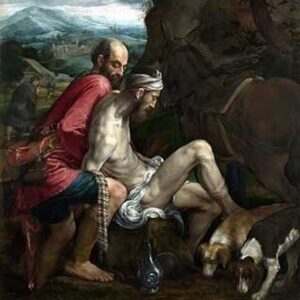“Let’s read somebody new,” my husband said. (New to us, he meant.) He chose British novelist Penelope Fitzgerald (1916-2000)—and began getting her books from the library, two at a time. When he finished each, he’d pass it on to me.
My favorite so far happens to be her final novel, The Blue Flower (1995). It’s a historical novel, focused on the life of Friedrich von Hardenberg (1772-1801). Hardenberg—or Fritz, as he’s called by family and friends—became famous when he began publishing under the name of Novalis, the` major German Romantic poet.
But it’s not his poetry that interests Fitzgerald; it’s his young adult life. His university studies, especially with German idealist philosopher Johann Gottlieb Fichte and poet-philosopher Friedrich Schlegel. His passionate love for twelve-year-old Sophie von Kuhn, his engagement to her when she was thirteen, and her dying from consumption at age fifteen. In fact, as Fitzgerald deftly indicates, Fritz’s idealism and his love for Sophie are of a piece.
Though these are central motifs for Fitzgerald, what’s extraordinary and delightful is her gift for evoking details of daily life. The novel opens with a comic scene of Fritz’s family on washday—the children’s underwear “flutter[ing] through the blue air, as though the children themselves had taken to flight.” Later there’s the escapade of Fritz’s young brother losing his favorite cap. And then there’s a family of Fritz’s friends, sitting together smoking a pipe in their new garden house—”half-asphyxiated by the fragrance of hop-vines, honeysuckle and tobacco.” Even Fritz’s first sight of Sophie is rendered lightly: no somber drum rolls, just an (almost) ordinary business visit to her family’s home. First Fritz is comically accosted by her young brother George who boldly tells him, “Your horse is no good. Why don’t you buy another one?”
Fritz did not heed either George or the company, who like the incoming tide on a shallow beach parted and re-formed behind the interesting newcomer…. But he remained fixed, gazing intently down the room.… At the back of the room, a very young dark-haired girl stood by the window, tapping idly on the glass….
The girl’s mother asks her, “in an undemanding, indeed soothing tone,” why she’s looking out of the window.
"I'm willing it to snow, mother. Then we could all amuse ourselves."
"Let time stand still until she turns round," said Fritz, aloud.
"If the soldiers came past, we could throw snow at them," said Sophie.
"Söphgen, you are twelve years old, and you don't seem to notice that we have
guests," her mother said.
At this she did turn around, as though caught by a gust, as children do in the
wind.
"I'm sorry, I'm sorry."
And that’s the end of the chapter. It’s the start of Fritz’s tragic passion, but we get no foreboding—just (except for Fritz’s wish about time) the everyday details.
Even Hardenberg’s invention of “The Blue Flower”—Fitzgerald’s title term—is inserted into everyday scenes. Fritz is reading to his friend Karoline Just (who loves him hopelessly) and then to Sophie and her sister, what he has written as, he says, “the beginning of a story.” It includes these lines:
The young man lay restlessly on his bed and remembered the stranger and his stories. "It was not the thought of the treasure which stirred up such unspeakable longings in me," he said to himself. "I have no craving to be rich, but I long to see the Blue Flower. It lies incessantly at my heart, and I can imagine and think about nothing else.… It is as if until now I had been dreaming…"
Karoline, Sophie, and her sister struggle to understand what the Blue Flower is, or means; but Fritz won’t—or is unable to—elucidate.
Hardenberg never did finish the novel which opens with the mention of the Blue Flower. But German Romantic poets picked up the image as their key symbol of longing—of yearning for an unreachable Absolute.
And throughout her book, Fitzgerald gives us many instances of the Absolute in Hardenberg’s imagination—instances of what I’d call his mysticism (though she doesn’t use that term). There are the “transfigurations” that he’d sometimes experience—as when he walked into a friend’s house and saw everything and everyone as “beautiful” because, he explained, he was seeing their “spiritual selves.” Later, in a graveyard, Fritz sees “a young man…standing still in the half-darkness,…speechless as a memorial. The sight was consoling to Fritz, who knew that the young man, although living, was not human, but also that…there was no boundary between them.” And Fritz says aloud: “The universe, after all, is within us. The way leads inwards, always inwards.” Then later the Schlegel sisters, anticipating a visit from Fritz, joke that he’ll be “saying something about the Absolute”—that “For him there is no barrier between the unseen and the seen.”
Remarkably, Fitzgerald has created in her novel a writing style that embodies this mysticism of Fritz’s. While historical novels are often dense with historical context, Fitzgerald gives this context without ever being ponderous. Her writing is light, deft, even diaphanous; while everything is solid, it seems to be illuminated from within.
In the superb Introduction to my 2013 edition of The Blue Flower, Candia McWilliam picks up this theme, noting how the novel gives “a life to the physical such that it radiates metaphysically.” Hardenberg’s life, McWilliam goes on, “was full of such flips of transfiguration, dark to light to dark again. This making light out of the dark is repeatedly effected by Fitzgerald.”
In her play with light and dark, Fitzgerald is also silently anticipating what would be the theme of Hardenberg’s Hymns to the Night, the six-poem sequence which he published as Novalis and for which he became famous. I say “anticipating” because Fitzgerald ends her novel before Hardenberg became Novalis—indeed before Sophie’s death. But it was his grief at her loss that inspired these poems.
Light and dark interact in the Hymns. The first poem begins with a celebration of Das allerfeuliche Licht—”The all-joyful light,” “undulating, / Color-filled, raying / Its mild omnipresence / By day. / As life’s inmost soul / It is breathed / By the giant world / Of restless stars / Who swim in its blue ocean…” But then “Downward wend I my way / To Night, holy, inexpressible, / Secret filled / …How dreary, forlorn her abode!” Another of the poems begins as an ode to “O cheerful Light— / You inspire me with joyful life.” Then, “But true to the Night / And her daughter, / Creative Love, / Rests my innermost heart.” Light’s pleasures cannot “outweigh / The enchantments of death.” And the final poem, titled “Yearning for Death,” expresses Hardenberg’s wish to die, since he has lost his beloved: “All hail, then, to eternal night, / All hail eternal sleeping.”
As Fitzgerald notes in her Afterword, Fritz didn’t have to wait long for his wish to be fulfilled. Along with two of his siblings, he succumbed to tuberculosis at age twenty-eight.
But he lives on as Novalis—and as the subject of Fitzgerald’s brilliantly engaging novel.
Peggy Rosenthal has a PhD in English Literature. Her first published book was Words and Values, a close reading of popular language. Since then she has published widely on the spirituality of poetry, in periodicals such as America, The Christian Century, and Image, and in books that can be found here.





